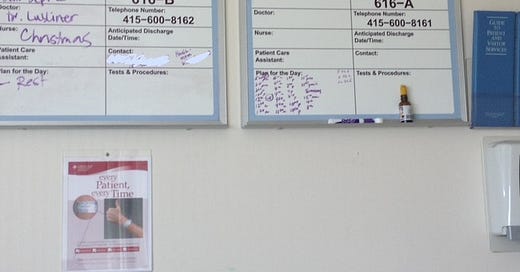The 4 Cs, Part One: Coverage Isn’t Access
Why Medicaid cuts, formulary tiers, and GTN pressure reshape Patient Support from the inside out.
Welcome to Part 1 of The 4 Cs. If you're just joining, this series is my take on the four root issues Patient Support is always trying to solve: Cost, Coverage, Care, and Compliance. (Yes, I toyed with calling it CACA. Think I still might.) Start with Part Zero if you want the overview and tone check.
Here’s the thing: for all the handwringing over the Big Beautiful Bill (BBB), it’s actually A-OK for Pharma as an industry.
All that Most Favored Nation (MFN) talk? Bluster. As Mariah said about J.Lo: “I don’t know her.”
Pharmacy Benefit Manager (PBM) reform? Didn’t happen.
Manufacturers aren’t fans of PBMs, but my inner cynic suspects the industry doesn’t actually want them to disappear. (More on that another time.)
The Orphan Cures Act? A clear Pharma win.
Under the original Inflation Reduction Act (IRA), orphan drugs were safe from Medicare price negotiation, BUT only if they treated a single rare disease. If a therapy had more than one indication, even if both were rare, it got tossed into the negotiation pool.
The result? Pipeline choices driven by commercial math, not Patient need.
The Orphan Cures Act changed that. As long as all indications are for rare diseases, the exemption still applies. It’s not a free-for-all, but it does remove a major disincentive.
Right or wrong, it gives Pharma more breathing room to go after multiple rare conditions. And that matters, not just for pipelines, but for how Coverage and Patient Support might need to flex in the years ahead.
So what does this have to do with Patient Support?
Drug prices aren’t coming down.
But one of the 4 Cs of Patient Support is directly affected by the BBB:
Coverage.
The BBB's sweeping cuts to Medicaid mean that as many as eleven million Americans will lose their health insurance.
They lose their safety net.
And yes, I have big feelings about this.
Because if you're okay with these cuts, you’ve never experienced a day of bad luck in your life. Because you can do all the right things, be born with healthy genes in a great ZIP code, and Bad. Things. Still. Happen. I worked in hospitals for nine years, almost all of them in pediatric clinics, and I can confidently say that no parent ever planned to be sitting in those waiting rooms.
And if you agree with me that sure, cutting coverage for kids is bad, but adults need to take responsibility for themselves, let me share a grim tale of a healthy, 7-time marathon finisher who always held down a job from the second she could get working papers at 15, and picked up drug-resistant C.diff. She ended up in the ICU with multiple-organ failure, was typed for a liver transplant, and needed dialysis.
Hi. That would be me. And my "out of network" care put me $60K in debt until I got on government-sponsored health insurance.
And, not that you asked, that "out of network" care saved my life, my liver, and my kidneys.
Don’t think it can’t happen to you or your loved ones. "There but for the grace of God," as my Dad would say. But he'd always add, "God doesn't pick favorites."
All that said, here's where I'm going to say the REALLY ugly stuff out loud:
Medicaid is important to Patient Support, but Medicaid is not a commercial priority in Pharma.
It simply can't be, because you're talking pennies on the dollar.
Gross-to-net revenue on a Medicaid script is dramatically lower than what commercial or Medicare payers typically yield. In some cases, brands may actually lose money per script, thanks to:
Mandatory Rebates: Manufacturers must provide at least a 23.1% rebate on branded drugs under Medicaid.
Best Price Provision: If a manufacturer gives a lower price to any other payer, they must match it in Medicaid, effectively putting a floor under all pricing strategies.
Supplemental Rebates: Many states (or pooled purchasing groups) negotiate additional rebates on top of the federal ones.
340B Impact: Medicaid utilization overlaps heavily with 340B-discounted prescriptions, which also drain margin, even when the drug is reimbursed through a commercial specialty pharmacy.
From a revenue lens, Medicaid is rarely material to brand forecasts.
But if you’re worried about “dual eligibles,” those Patients who qualify for both Medicare and Medicaid, don’t panic (yet). Most still qualify under income and asset rules. Their eligibility hasn’t changed under the BBB. The bigger risk? Administrative churn and redetermination failure.
Who counts as Dual Eligible?
Dual-eligible individuals qualify for both Medicare (federal) and Medicaid (state-administered). Roughly 12 million people in the U.S. fall into this group. They’re often:
Older adults with low income
People under 65 living with disabilities
Patients with complex, chronic medical needs
They typically use Medicare for hospital and outpatient services (Parts A and B). Medicaid helps cover what Medicare doesn't, including premiums, deductibles, long-term care, transportation, and home health services.
So, if Medicaid isn't a priority for Commercial Pharma (don't get me wrong, there are exceptions; HepC and HIV immediately come to mind), why bring it up at all?
Because those Patients who have lost Medicaid are going to do one of two things:
Disappear. No, not literally. I'm not that dark (but maybe I should be).
But you will see both generic and brand name drug use drop. Before you say, "But they're going to get off their butts and find jobs!" consider how Walmart’s and McDonald’s employees make up a great percentage of working adults on Medicaid. Employment has never equaled coverage, even when employers offered health insurance.
Seek out Manufacturer Patient Support, and specifically free product programs. I'm going to explore Patient Assistance Programs (PAPs) more in Part 2, stay tuned.
And while the headlines are (rightly) focused on Medicaid disenrollment under the BBB, let’s not pretend Coverage is smooth sailing for Patients who do have insurance. I’m talking about prior authorizations, high staff turnover in HCP offices with no process memory, and plans that haven’t even loaded the NDC yet. Let’s add in the fun twist of medical-benefit billing with a mystery J-code and coverage info that changes depending on which payer rep you speak with.
Coverage isn’t the same as access.
A formulary listing doesn’t guarantee that Patients can navigate the red tape to actually start treatment.
So let’s take a breath and talk about what “coverage” really means.
If a drug is “on formulary,” that just means it made the list, not that it’s accessible to Patients. What actually matters is tier placement.
Top-tier drugs often come with lower out-of-pocket costs and fewer administrative hoops to jump through.
Drop down a tier or two, and now you’re talking higher coinsurance, step edits, prior authorization, or some combination of the above.
Coverage may exist on paper, but operational access is a different story.
And that’s exactly what it sounds like: your doctor has to get permission from the insurance plan before the Patient can start treatment. Sometimes they have to prove the Patient failed another therapy first. So yes, a drug can be “covered,” but still require days of back-and-forth, faxes, phone calls, and appeals, and that’s before a single dose gets shipped.
What is Prior Authorization, and Why Does It Exist?
The official line? Prior authorization helps control costs and safeguard clinical decision-making. The idea is to avoid waste, catch inappropriate prescribing, and push lower-cost options when they make sense.
In theory, it's a fair guardrail. Plans want to avoid paying for $12,000 drugs when a $200 one might work just as well. Manufacturers, in turn, are expected to justify a product’s place on the formulary by showing clinical and economic value. That’s the game.
But in practice, PA has become a blunt instrument. It creates administrative burden for providers, delays treatment for Patients, and often becomes a paperwork war of attrition. It’s not just about clinical appropriateness; it’s about cost management, network steering, and sometimes, hoping the office or Patient gives up.
I've often shared my belief that one way or another, Manufacturers pay for their pricing decisions:
Commercial discounts (e.g., wholesaler chargebacks, prompt pay discounts)
Copay assistance
340B pricing discounts
Medicaid rebates (calculated using the greater of: 23.1% of AMP or the best price in the market)
Medicare Part D coverage gap discounts
VA / DoD federal ceiling price discounts
Patient Assistance Program (PAP) costs (if the manufacturer books it as a GTN item, which varies by company… usually not, but QuickStart? that can be a brand breaker)
Returns, fees, admin costs (like distributor service fees)
Ok, you can look at the bullet list above, and think, "She's just listing all the stuff that rolls up into gross-to-net (GTN) calculations."
Guilty. I think more about GTN and Brand Margin a lot more often than folks would assume.
Why?
Because your payer mix (i.e., the ratio of commercially insured vs. government-insured Patients) and your Coverage assumptions aren’t just launch checklist items. They’re margin determinants. Full stop.
If you don't think Coverage assumptions affect your GTN math, I want to sit you down with a finance lead who just got handed a surprise Medicaid best price reset because some PBM got a sweetheart deal no one flagged. Or someone who thought 340B was just a rounding error until that rounding error swallowed 15% of their forecast.
Coverage isn’t just about access.
Coverage shapes cost. Coverage shapes GTN. Coverage shapes whether your Access team is fighting a fire with a hose, or a paper fan.
And for those wondering what this has to do with Patient Support, it’s everything. When Patients lose Medicaid, when prior auths drag out, when formulary placement comes with more strings than access, guess who they call? Not their plan. Not the pharmacy. Your hub. Your field team. Your PSP vendor. Your inbox. That infrastructure becomes the duct tape holding together a Coverage landscape that was never designed with Patients in mind. Patient Support is not just responding to the cracks. It is often the only thing keeping some Patients in the system at all.
So yeah. Welcome to Part 1.
When I meet with clients, I talk Coverage. Not as a hypothetical, not as a Patient story, but as the root system that props up your forecast, your Access plan, and your Patient Support budget, whether you planned for it or not.
Ignore Coverage, and it’ll break everything you’re trying to build.
Next up: Cost.
If this resonated with you, if you’re working inside Pharma and thinking, “It’s like she’s reading my mind,” you’re not alone. The POOP is where I say the quiet parts out loud about the Patient Support realities no one wants to present to the C-suite (or quietly screams in frustration when they do).
Parts 2-4 of this series will be for paid subscribers only.







